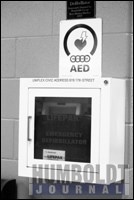On March 4, 1990, Hank Gathers, a star basketball player at Loyola Marymount University, slammed home an alley-oop dunk during a game against the Portland Pilots. While running back down the court, Gathers collapsed. He was dead within hours, a victim of hypertrophic cardiomyopathy, a thickening of the heart muscle that is the one of the leading causes of sudden cardiac death among athletes. Gathers had collapsed previously, but in many cases victims show no symptoms before death.
On March 10, 2014, Rich Peverley of the Dallas Stars nearly joined Gathers and many others as victims of cardiac problems when he collapsed on the bench during a game against the Columbus Blue Jackets. Fortunately for Peverley he was quickly treated with an automated external defibrillator (AED), a device that establishes regular heart rhythms through the use of electrical pulses. AEDs are meant for use in cases of sudden cardiac arrest, when the heart stops beating and victims often aren't breathing and have no pulse; they will not shock someone who is having a heart attack (or myocardial infarction), when the flow of oxygen is restricted to the heart.
In Peverley's case, he is scheduled to undergo surgery to address his irregular heartbeat. Though his season is over, he is alive, thanks in no small part to quick and effective treatment, including the use of an AED.
But what if what happened to Rich Peverley or Hank Gathers happened to a member of the Humboldt Broncos, or someone out for a leisurely skate at the Elgar Petersen Arena? Would they be as lucky as Peverley was?
It's impossible to say for sure, but residents of Humboldt should be reassured by the fact that there are two publicly available AEDs at the Uniplex: one has been in the lobby of the Elgar Petersen Arena for four years, while the other is just outside of Jubilee Hall. (There is also a third defibrillator in the staff room for pool lifeguards, though that one isn't available to the public.) The AEDs were installed after consultations with the Canadian Recreation Facilities Council, one of several organizations that advocate for the presence of AEDs in all recreational facilities.
"They recommended that we put them in central areas that are visible and close to staff," said Darrell Lessmeister, Humboldt's director of community and leisure services.
Uniplex staff members are trained to use the AEDs, although they should be useable by anyone. According to Lessmeister, they have only been used once or twice since being installed. At first there was only the one in the arena lobby, but after someone at a wedding in Jubilee Hall needed an AED, a second defibrillator was installed in the convention centre.
"Nothing is fool proof, but they're as close to it as you can get," Lessmeister said.
According to the Heart and Stroke Foundation of Canada, there are up to 40,000 deaths attributable to cardiac arrest in the country ever year, or one every 12 minutes. Studies have shown that every one-minute delay in defibrillation can decrease the chances of survival by seven to 10 per cent and that, combined with CPR, the use of an AED can increase the likelihood of survival by 75 per cent or more.
Even so, there are no laws on the books in Saskatchewan that mandate the presence of AEDs in public places like gyms or arenas. In Manitoba, The Defibrillator Public Access Act required the installation of AEDs in high-traffic public places by Jan. 31, 2014, making Manitoba the only province in the country with such a law.
"That is something we'd like to see clear across Canada," said Mike Hoffman, manager of National AED Programs with the Heart and Stroke Foundation of Canada.
Hoffman said the primary obstacle to legislation mandating AEDs in almost every public place is cost.
"The downside is forcing companies to pay out of their pockets for machines," he said. "It's the cost factor. It's an added cost to the site, so it can be difficult."
Thus far the Heart and Stroke Foundation has deployed approximately 7,500 AEDs across Canada, though that's far from where they want it to be.
"We want AEDs to be deployed as commonly as fire extinguishers," Hoffman said. "Wherever the public is, AEDs should be there. Any building that the public can have access to, we'd love to see AEDs in those areas."
Among those is an arena in Ontario, where Hoffman said a 65-year-old man collapsed while playing hockey the day after the Peverley incident. There was an AED on site and the man was revived and is now doing well. Those are the kind of stories that Hoffman wants to become more and more common.
"We want it to get to the point where it's second nature for people to know what to do with an AED," he said. "They see it, they grab it and they move."



